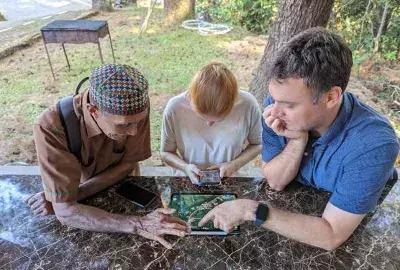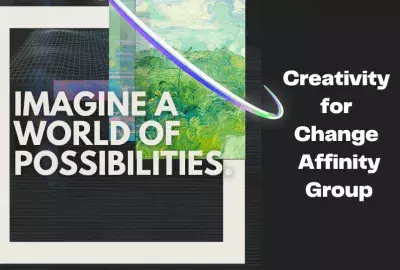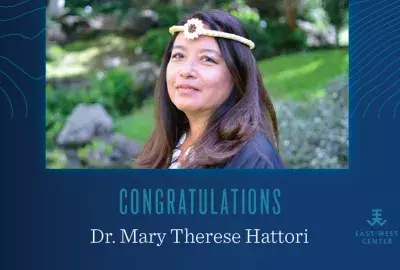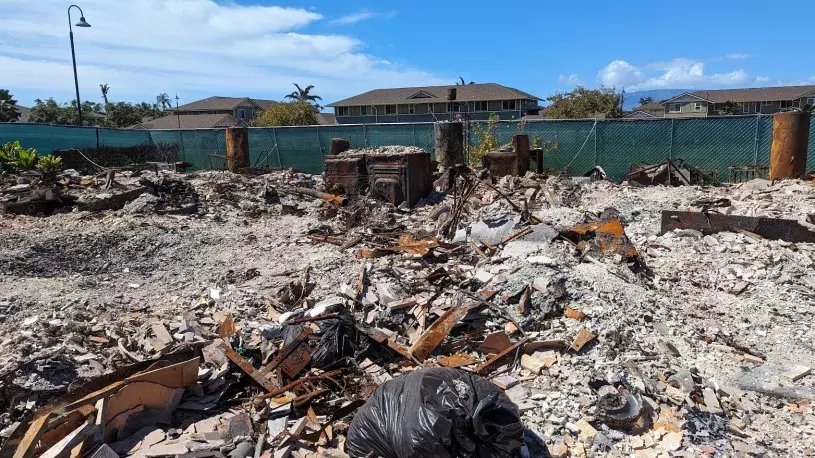
OFFICE/DEPARTMENT
EWC Senior Fellow, Sumeet Saksena recently travelled to Maui to kick-start the Lahaina Environmental Assessment Project (LEAP), which aims to collect dust and ash samples from properties affected by the August 2023 wildfires to look for residues present after the fire that may affect the health of those exposed.
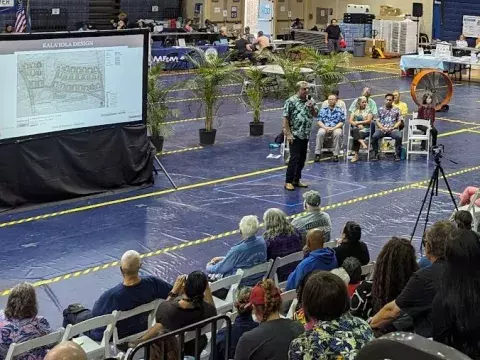
While on Maui to discuss the project with key stakeholder groups, Saksena was encouraged by local community groups to attend the weekly Disaster Recovery Community Update meeting at the Lahaina Civic Center where the mayor and representatives from federal, state, and local governments presented. The week’s theme was the housing problem—with over 4,500 households displaced by the fires, the likely contamination of the soil, water, and air is important factor in the re-building process from a public health perspective.
Saksena came away from the meeting touched by the deeply human stories he heard and with a better understanding of how to best support recovery efforts. “I had been trying to find a way to frame our research endeavor in a way that citizens can easily understand. An interaction between two affected citizens, during the Q&A session, provided me the answer. One of them described her housing problem as complex and unique and sought a remedy for it. Promptly, another citizen responded to her by saying that while he empathizes with her situation, it is time for all affected citizens to focus on their common problems first. That provided me with a clue about the framing.
“We environmental scientists know that pollutants respect no borders. Not in the air. Not in the water. Not in the soil. Winds and currents carry pollutants across property boundaries, administrative boundaries, and watersheds. No matter how efficiently an affected citizen cleans up his/her land and property, if the property is downwind of a still contaminated parcel, eventually his or her health will be affected in the long run. Likewise, the toxic substances on that citizen’s property are going to adversely affect the health of his/her neighbor who is downwind of the property. The likely toxic soil, ash, and dust in Lahaina is a common problem for the displaced and even for those just outside the burn zone who were not displaced.”
LEAP is a collaboration between the East-West Center, the Chemical Insights Research Institute of UL Research Institutes, and Duke University to systematically collect dust and ash samples from a number of property boundaries on Maui. This study will obtain valuable data on chemical and inorganic residues present after the fire that may present environmental health challenges to those exposed. The information can lead to mitigation approaches and recommended processes for reducing exposures and protecting public health.
EWC Senior Fellow, Sumeet Saksena recently travelled to Maui to kick-start the Lahaina Environmental Assessment Project (LEAP), which aims to collect dust and ash samples from properties affected by the August 2023 wildfires to look for residues present after the fire that may affect the health of those exposed.

While on Maui to discuss the project with key stakeholder groups, Saksena was encouraged by local community groups to attend the weekly Disaster Recovery Community Update meeting at the Lahaina Civic Center where the mayor and representatives from federal, state, and local governments presented. The week’s theme was the housing problem—with over 4,500 households displaced by the fires, the likely contamination of the soil, water, and air is important factor in the re-building process from a public health perspective.
Saksena came away from the meeting touched by the deeply human stories he heard and with a better understanding of how to best support recovery efforts. “I had been trying to find a way to frame our research endeavor in a way that citizens can easily understand. An interaction between two affected citizens, during the Q&A session, provided me the answer. One of them described her housing problem as complex and unique and sought a remedy for it. Promptly, another citizen responded to her by saying that while he empathizes with her situation, it is time for all affected citizens to focus on their common problems first. That provided me with a clue about the framing.
“We environmental scientists know that pollutants respect no borders. Not in the air. Not in the water. Not in the soil. Winds and currents carry pollutants across property boundaries, administrative boundaries, and watersheds. No matter how efficiently an affected citizen cleans up his/her land and property, if the property is downwind of a still contaminated parcel, eventually his or her health will be affected in the long run. Likewise, the toxic substances on that citizen’s property are going to adversely affect the health of his/her neighbor who is downwind of the property. The likely toxic soil, ash, and dust in Lahaina is a common problem for the displaced and even for those just outside the burn zone who were not displaced.”
LEAP is a collaboration between the East-West Center, the Chemical Insights Research Institute of UL Research Institutes, and Duke University to systematically collect dust and ash samples from a number of property boundaries on Maui. This study will obtain valuable data on chemical and inorganic residues present after the fire that may present environmental health challenges to those exposed. The information can lead to mitigation approaches and recommended processes for reducing exposures and protecting public health.





